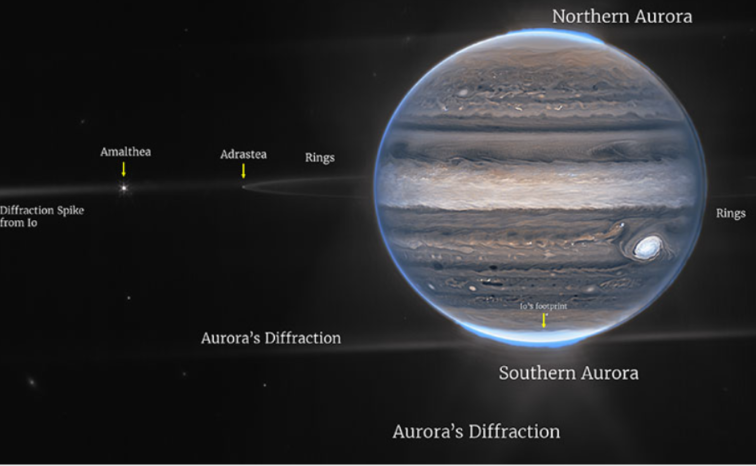Welcome back Jupiter!

You may have noticed how Jupiter shines these nights. It dominates the sky and if it is clear you will see it already at dusk. It is indeed the brightest object visible in the night (after the Moon, of course).
“The first mission to Mars did not expect to find craters and river valleys, and yet they did. The first mission to Jupiter didn’t expect to find ocean worlds and volcano worlds, but they did.”, Alan Stern, planetary scientist.
All bodies revolve around the Sun in an elliptical path, so they have a point when they are closest and a point when they are farthest from the Sun. When the transits of the Earth pass by Jupiter, it is very close to the Earth.
In fact, this year Jupiter is closest to us in the last seventy years, i.e. 591 million kilometers. That is why its magnitude is high and amounts to -2.9 m.
Otherwise, Jupiter enters opposition approximately every 13 months*. That’s how long it takes the Earth to go around the Sun once in relation to Jupiter. This again means that the opposition of Jupiter comes one month later every year.
JWST: New photos of Jupiter
The excitement of scientists about the good quality of the photos coming from the James Webb Space Telescope (JWST) is by no means abating, as the increasingly popular telescope is constantly sending new magnificent images.
This time it’s about Webb’s view of the largest planet of the solar system, Jupiter. Indeed, so much can be seen in these recordings, certainly more than scientists expected.
NASA, ESA, Jupiter ERS Team; image processing by Ricardo Hueso (UPV/EHU) and Judy Schmidt, CC BY 4.0, via Wikimedia Commons
JWST photographed Jupiter with a near-infrared camera, so it recorded infrared waves, which the human eye cannot detect. Therefore, in order to see a visual record, this infrared light is converted into the visible spectrum.
This results in a wonderful, detailed photograph, but with unusual colors and certainly not the kind we are used to seeing in Jupiter images. The longest wavelengths in the photo are given a reddish tint, and the shortest wavelengths are bluish.
This is a composite image, which means that it is made up of several individual shots. We see the planet itself, but also what is truly rare: Jupiter’s ring, and then two of Jupiter’s moons: Amalthea and Adrasthea. The blue glow around Jupiter’s poles are the auroras.
Amalthea is the bright spot on the far-left side of the photo, and Adrasthea is the pale spot on the edge of the ring.
Take a look at the video below.
Did you know?
- The Moon and Jupiter are in reality very far from each other. Speaking in numbers, we are separated from the Moon by hundreds of thousands of kilometers (373,136 km), from Jupiter by hundreds of millions of kilometers (596,138,828 km).
- We see both of them thanks to the reflection of the Sun’s rays falling on their surface (Moon) or dense atmosphere (Jupiter). The moon and planets do not have their own source of light, if there were no sun they would be invisible.
- *This is an ideal period to observe Jupiter because it is now in opposition to the Sun. In astronomy, opposition means the position of a body when, as seen from Earth, it is on the opposite side of the Sun. Then that body is in the sky for the whole night, rises already with dusk, and sets before dawn.
- Hey, did you notice the cover photo? On the left side is the very first Jupiter photo and on the right is the latest James Webb shot!
Do you have a telescope?
At midnight, Jupiter is quite high, and that’s when it and its suite of satellites are best for observation.
If you have a telescope, pay attention to Jupiter’s stripes and, above all, to its great red spot. That red spot is a storm that has been raging for at least four centuries since it was first observed.
Jupiter turns around its axis in less than ten hours, so you have a good chance of seeing that spot, if not one night, then the next.
Oh, did you know that here at OSR you can name real stars? Brilliant, isn’t it?

